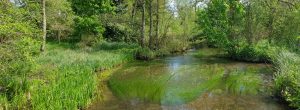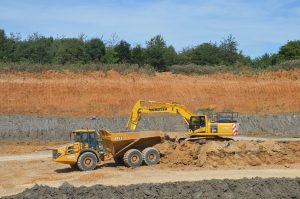Panshanger Park is 1,000 acres of countryside situated between Welwyn Garden City and Hertford. Herts and Middlesex Wildlife Trust is working with the park’s owners, Tarmac, to manage the park for both people and wildlife.
As you’re walking around Panshanger Park, you may be enjoying seeing the wide variety of wildlife that calls it home. You may also be interested in the heritage of the site, seeing relics of such as the orangery and the remains of the house. What you may not have considered is the slightly more hidden aspect of the park, the rocks.
The predominant rock under the ground at Panshanger Park, known as bedrock, is chalk. Common in the South East of England, chalk is a porous rock and was originally formed when the land was under a warm, clear sea millions of years ago!
Chalk forms some of the features such as the chalk river, the River Mimram, which flows through the centre of the valley. The porous chalk beneath the ground in this area of the South East, stores water like a large – albeit non-squishy – sponge, known as an aquifer. As well as being the source of water for some of our chalk rivers, they also supply our drinking water.
 The River Mimram flowing through Panshanger Park is a chalk river. Jo Whitaker.
The River Mimram flowing through Panshanger Park is a chalk river. Jo Whitaker.
However, the chalk is only close to the surface in the valley bottom of the park. On the slopes of the valley, there are gravel and unsorted rock deposits, meaning the rock is made up of lots of different sized sediments.
Some of these rocks, such as flint pebbles, were deposited by the River Thames when it used to flow through Panshanger around a half a million years ago. You may see some of these flint pebbles along the field edges when you’re walking around the park. The more unsorted rocks – known as till – were left by glaciers during the last glaciation about half a million years ago!
Panshanger used to be a quarrying site and the extracted gravel was used for housing builds and roads. The large lakes at Panshanger were once quarrying areas which were left to fill with water as part of the restoration of the park, creating excellent habitats for wildlife. After quarrying finished, the area was restored back to the parkland and nature reserve you see today.
 The geological layers can be seen in a vertical cut through before it is filled back in with inert soil. Michael Charlton.
The geological layers can be seen in a vertical cut through before it is filled back in with inert soil. Michael Charlton.
So, when you’re next out on a walk around the park, you now know what’s beneath your feet! If you’d like to learn more about the geology of Panshanger Park, then join us on our upcoming guided walk on 21 February. More information and booking details can be found at panshangerpark.co.uk.
Jo Whitaker is the Panshanger Park people and wildlife officer. She works for Herts and Middlesex Wildlife Trust and her role is funded by Tarmac.


